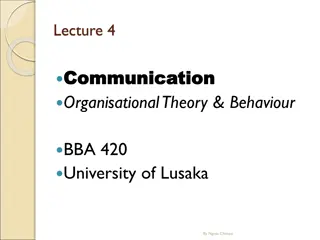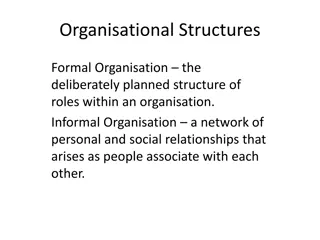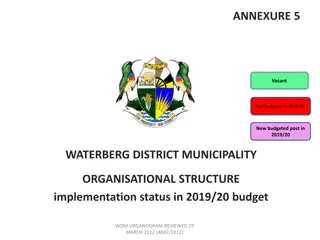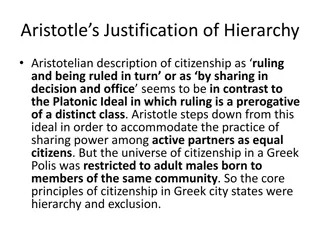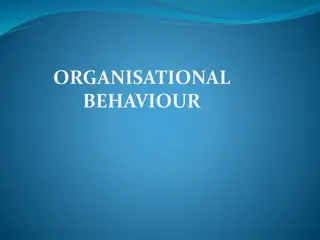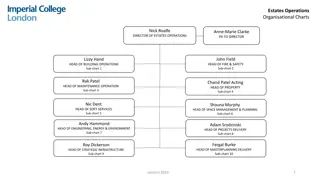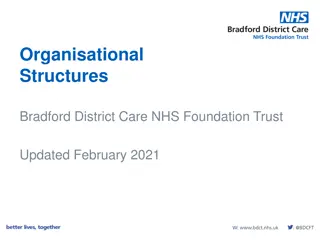Understanding Organisational Structure and Hierarchy in the Workplace
Organisational structure plays a vital role in defining how a business operates, encompassing elements like hierarchical arrangements, functional areas, and chain of command. Hierarchy within an organization determines accountability and communication channels, while the span of control impacts supervision levels. Explore different structures and their implications on effective management and decision-making processes.
Download Presentation

Please find below an Image/Link to download the presentation.
The content on the website is provided AS IS for your information and personal use only. It may not be sold, licensed, or shared on other websites without obtaining consent from the author. Download presentation by click this link. If you encounter any issues during the download, it is possible that the publisher has removed the file from their server.
E N D
Presentation Transcript
B1 What would be the features of your perfect job? STRUCTURE AND ORGANISATION STRUCTURE AND ORGANISATION
STRUCTUREANDORGANISATION In this topic you will learn about Organisational structure, e.g. hierarchical structure, flat structure, matrix structure, Holarctic structure Functional/operational areas, e.g. Human resources, research and development, sales, marketing, purchasing, production and quality, finance, customer service, IT, administration
ORGANISATIONALSTRUCTURE Organisational design is the framework that provides a business with a structure to achieve its objectives Organisational structure is the way in which the workforce within a firm is organised, including job roles and communication flows Organisational charts provide a visual representation of the organisational structure Managing Director Finance Manager Production Manager Accounts Supervisor Sales Supervisor Production supervisor
HIERARCHY Hierarchy is the structure of the workforce within an organisation showing who is accountable to whom The levels of hierarchy within firms will differ: tall and thin structures occur where each superior is responsible for a few subordinates this allows for closer supervision and communication between the two levels What is the link between hierarchy and pay? wide and flat means that each superior is responsible for a large number of subordinates this requires greater delegation but fewer levels allowing for quicker communication through the firm
CHAINOFCOMMAND Chain of command is the way authority and power is passed down the levels of hierarchy The chain of command will be from the top of the organisation structure downwards The longer the chain of command the slower communication and potentially decision making It is however important that communication can flow in both directions
SPANOFCONTROL The span of control shows the number of subordinates that a manager or supervisor is directly responsible for If a manager has many subordinates this is called a wide span of control If they have few subordinates this is called a narrow span of control Why do you think there are so many ranks within the armed forces? The size of a manager's span of control is likely to influence the amount of supervision i.e. with a narrow span of control a manager only has a few subordinates and can therefore supervise them closely
INPAIRS Using A3 paper produce an organisational chart for your school or college On your chart show the various departments, year groups and staff Try to work out: the height of the hierarchy is it tall or flat? the span of control of the different members of staff are there any areas of contradiction? how efficient is this structure? You will need to know the organisational structure of your 2 businesses. If you already know this you could draw an organisational chart for them instead in preparation for your assessment.
AUTHORITY Authority is the power of an employee to instruct subordinates, make decisions and control the use of resources Understanding of authority and centralisation and decentralisation may help you to analyse how the structures of your two businesses allow them to achieve success. This is a merit criteria. Authority can be: Centralised i.e. maintained by a few at the centre of the organisation Decentralised i.e. spread across the organisation Authority can act as a motivator
CENTRALISEDANDDECENTRALISED Centralisation is when the responsibility for decision making is maintained, by a limited number of senior managers, at the top of the hierarchy Few decision makers Decisions are made by those at the top of the hierarchy Speeds up decision making Maintains tight control Bureaucratic
CENTRALISEDANDDECENTRALISED Decentralisation is when the responsibility for decision making is delegated to a number of middle managers throughout the hierarchy Delegates decision making Decisions made at many levels within the hierarchy Frees up management time Provides motivation Reduces bureaucracy
TYPESOFSTRUCTURE Work in pairs to complete the table below. A hierarchical structure Many levels of hierarchy Long chain of command Narrow span of control A flat structure Few levels of hierarchy Short chain of command Wide span of control Advantages Disadvantages Advantages Disadvantages
TYPESOFSTRUCTURE A matrix structure is one where teams are put together from different functional areas to work on specific projects Advantages Communication across functional areas Range of view points considered Functions support and understand each other Motivational Disadvantages Potential loss of control Dependent upon effective delegation Teams may take time to work together effectively Can cause conflict
TYPESOFSTRUCTURE A holacratic structure is one where authority and responsibilities are shared amongst the workforce A holistic approach where no one is the leader Teams will be formed to focus on specific projects Advantages Shared responsibility and authority Supports a skilled and innovative workforce Greater flexibility and ability to respond quickly to change Motivational Disadvantages Dependent on trust Many decision makers can pose a threat of conflict
FUNCTIONAL/OPERATIONALAREAS Functional or operational areas are departments within a business with responsibility for a specific area of business activity For example the production and quality function, also known as the operations management or resource management function, will be responsible for the activities that meet customers orders i.e. the main function of the business such as producing sauces or building sheds Responsibilities of this function will include: Turning raw material into finished goods or services Checking quality Maintaining machinery Receiving, storing and monitoring stock Distribution of finished goods
FUNCTIONAL/OPERATIONALAREAS Preparing for assessment. Functional areas include: Human resources Using two different colour pens can you give specific examples for your two businesses. Research and development Sales Marketing How does each function contribute to the success of the business? Draw a mind map to show the responsibilities of each of these functions. Purchasing Production and quality Finance Customer service IT Administration
STRUCTUREANDORGANISATION In this topic you have learnt about Organisational structure, e.g. hierarchical structure, flat structure, matrix structure, Holarctic structure Functional/operational areas, e.g. Human resources, research and development, sales, marketing, purchasing, production and quality, finance, customer service, IT, administration


